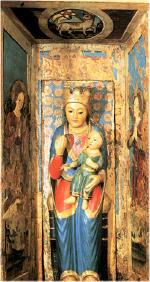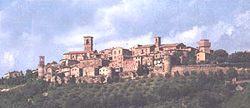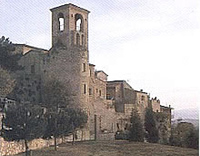Todi's country
Collazzone
According to the tradition, Collazzone's origins date back to Attone or Azzone who settled there supported by the Dukes of Spoleto, who were interested in having this outpost under their control as it was very important for the access and the control of the Tiber Valley.
The town stands on the top of a hill at almost 500 metres above the sea level in a region rich in woods of oaks, pine-trees and olive trees which make the climate particularly healthy. Because of its view, of its green woods and for the fact of being quite far from highway E45, Collazzone is particularly suitable for tourists, especially during the summer season.
The centre has all the essential characteristics of the Langobardic military architecture with its alleys which are concentric to the principal assembly place, its symmetrical and converging narrow streets, its walls, its bastions, its counterforts, its ramparts and its towers which are still untouched. The parish church dedicated to the martyr Saint Laurence, is particularly interesting, as it was built on the ruins of what once was the quarterdeck of the castle and as it preserves a precious polychrome wooden statue of the Madonna with the Child dating back to the XIV th century. Moreover there is the ancient church dedicated to Saint Angelo, which is inside the Convent of the Poor Clares to which it gives the same name.
Not far from the town there is the Convent of Saint Laurence, which was at first a Benedictine Abbey, whose crypt has preserved the charm of the Romanesque architecture. The Convent was the latest shelter of Jacopone da Todi who died here on the Christmas night, in 1306. On the charming Piazzetta Jacopone, built on the ancient cloister of the convent, stands the Palazzo Comunale (the Town Hall), whose portal, bearing the noble coat of arms of the Princes Cesi, was probably made by Vignola.
Modern hotels and accomodation facilities have made of Collazzone a longed-for destination for holidays



Collazzone
E' una terra antica , la miniera di lignite attiva a Collazzone testimonia che in ere geologiche molto lontane il territorio era ricco di boschi di conifere , di querce di castagneti. Il territorio è attraversato dal Tevere e dal torrente Puglia.
Ci sono antichità romane a " Collepepe" in località le " Le Carceri" dove si può ammirare un'arca di particolare interesse archeologico, databile tra la fine dell'età repubblicana e la prima età imperiale, costituita da una cisterna a quattro vani pavimentata in cotto e , poco distante, da una vasca rettangolare. Numerosi sono i personaggi che sono passati a Collazzone tra cui il Beato Sirmone, intorno al 1220, di famiglia nobile e potente che abbandonò le ricchezze per seguire la regola francescana predicando fino in Germania ed in Francia.
Collazzone e gli altri paesi del circondario hanno origine medioevale ed i loro centri storici sono racchiusi entro mura castellane. Tra le bellezze storico artistiche si può apprezzare la Chiesa di San Lorenzo del sec. XIX- XX, che sorge sull'originaria struttura della rocca, sulla facciata ha un grande rosone, mentre al suo interno vi è una preziosa scultura lignea del XIII sec. raffigurante la "Madonna con Bambino" ed "alati del tabernacolo", angeli di scuola umbra del XV sec.
La Chiesa e il Monastero francescano di San Lorenzo, risalenti ai secc. XIII-XIV, hanno al loro interno una cripta romanica , residenza prima dei benedettina poi clarissiana fino al 1370, anno del trasferimento della comunità monastica all'interno del castello di Collazzone. Altre emergenze architettoniche: Chiesa di San Michele Arcangelo, lungo l'attuale corso Vittorio Emanuele, nel 1370 fu annessa al convento clarissiano di San Lorenzo" dentro le mura". Di recente sono stati scoperti sulle pareti affreschi risalenti ai secc. XIV- XVI .